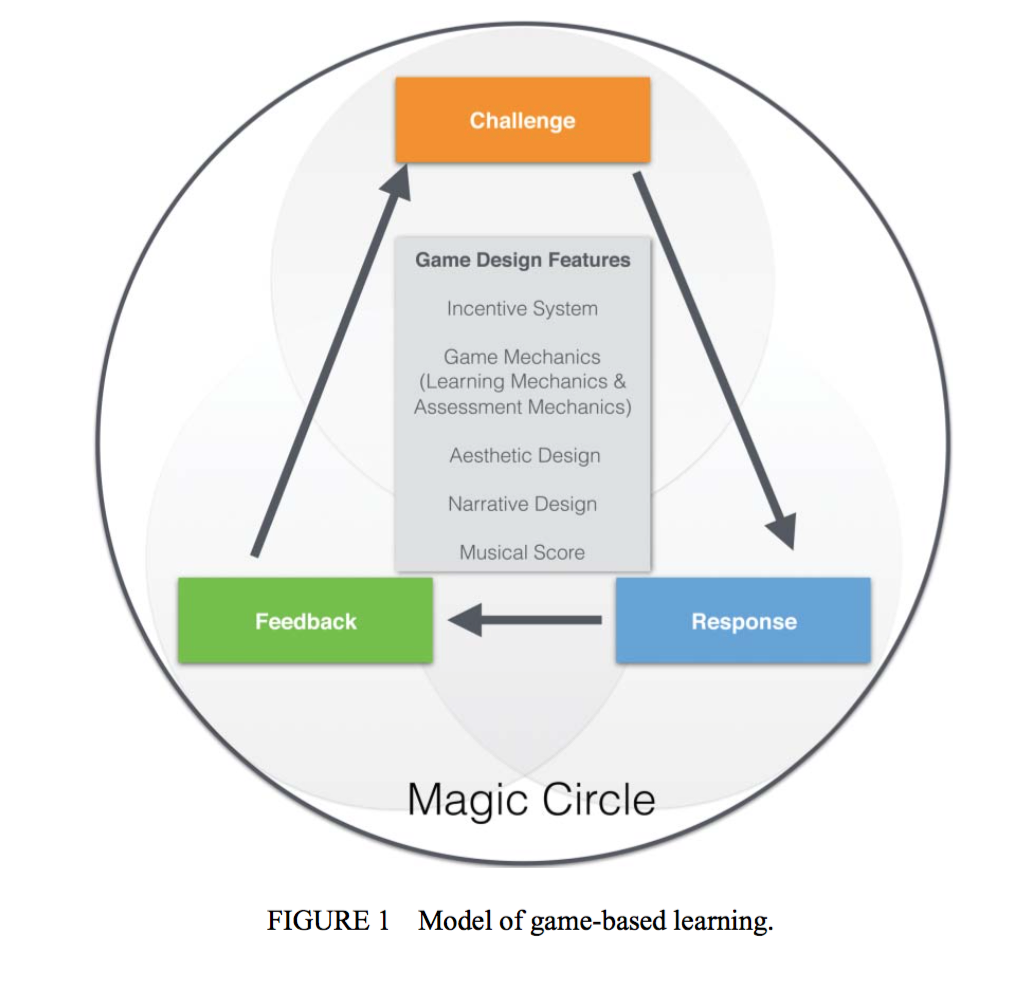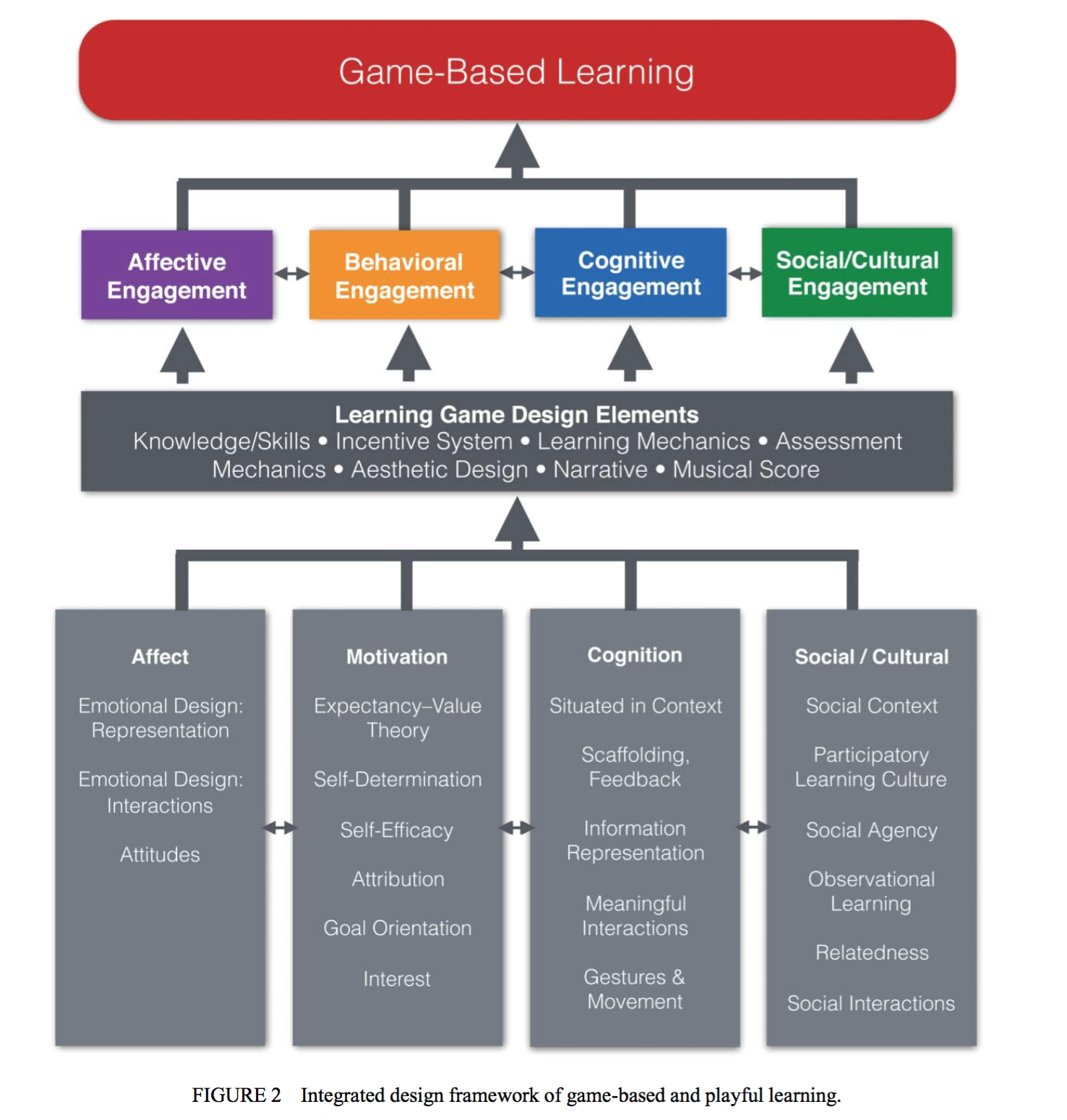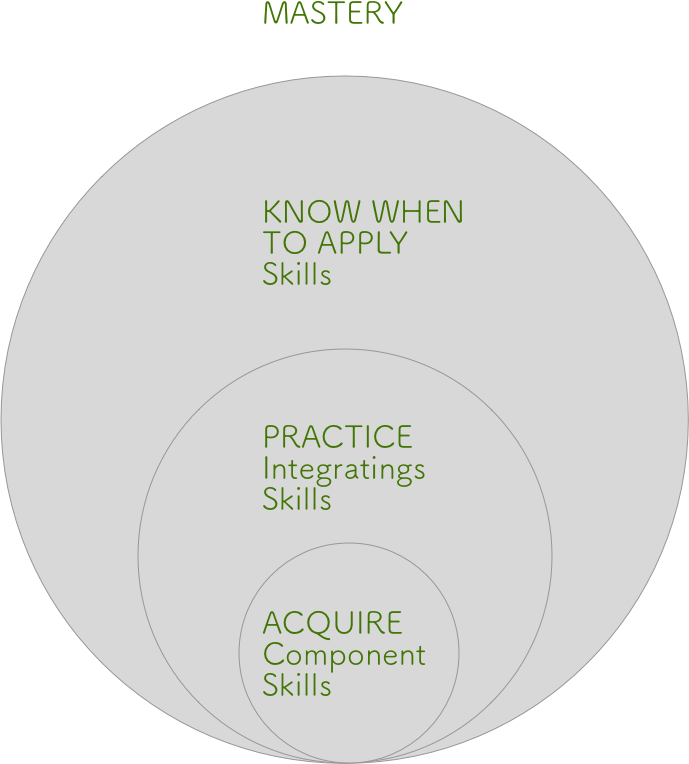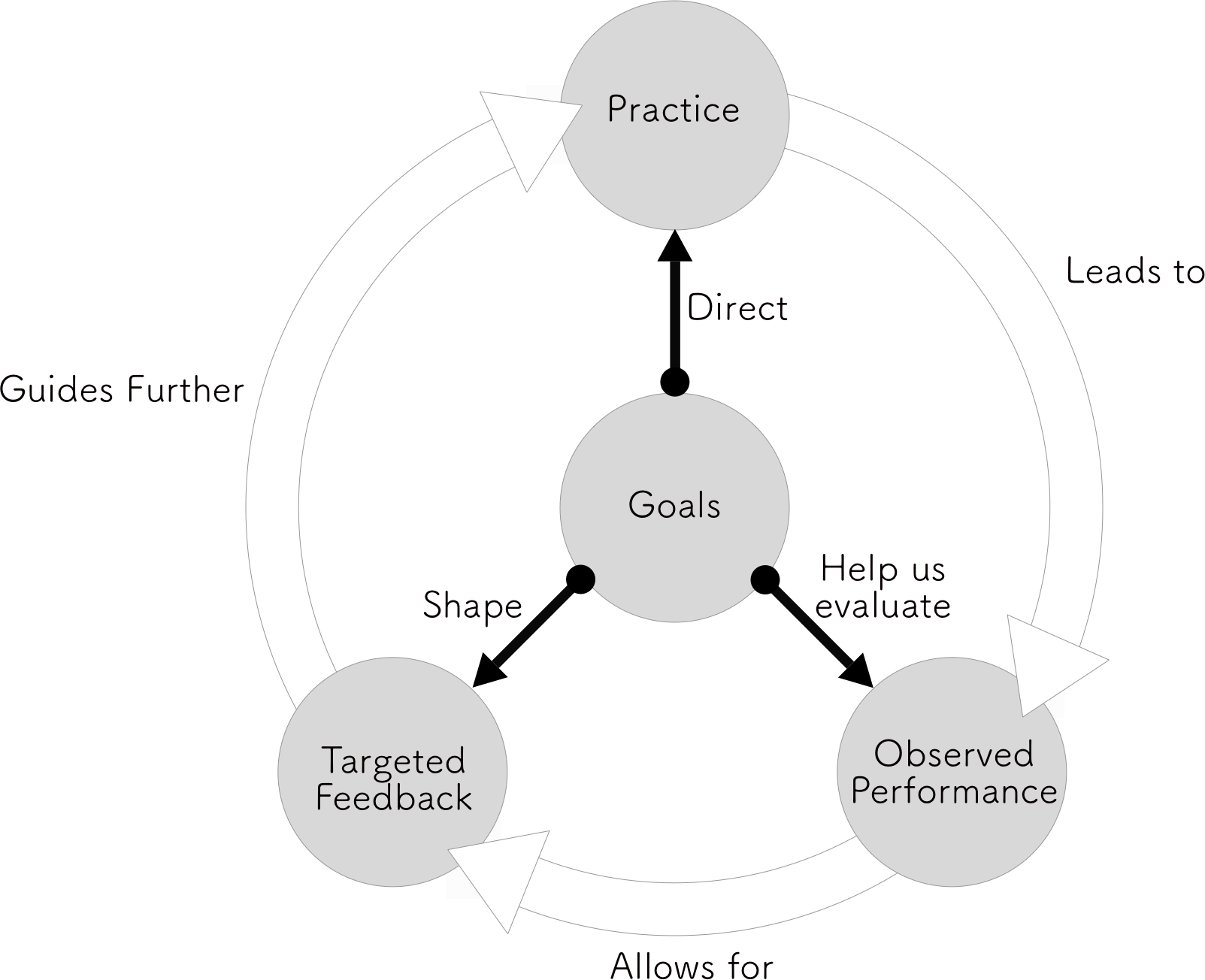Went to a guided visit of Berkley’s Robotic Learning Lab yesterday. What a beautiful campus and great work they are doing in the field… fascinating.
Engineering Education – Week 5.2 – Class Notes

Great class today with guest speaker – NYU professor Jan L. Plass – the author of this week’s reading on the foundations of Game-Based Learning.
The biggest takeaway was the distinction between a game-based learning experience vs. gamification. Gamification is a “buzz word” that people love to use or think of as a way to engage their users, to make their product more appealing, or effective. In reality, it’s a simple way of adding game-based features such as points, badges, or reward systems…
Engineering Education – Week 5.2 – Reading Notes
Reading:
Jan L. Plass, Bruce D. Homer & Charles K. Kinzer (2015) Foundations of Game-Based Learning, Educational Psychologist, 50:4, 258-283
Summary:
I highly appreciated the reading in the sense that it does not claim to have found a holistic and generalizable theory or framework for game-based learning. It comprehensively analyzes the several aspects or considerations one takes (or should take) into account when designing a game-based learning experience, and concludes that no single approach is the most effective or essential. It also states that when designing, one can use several learning theories and several game design aspects to enhance the experience.
“In this article we argued that the integrated viewpoints of cognitive, motivational, affective, and sociocultural perspectives are necessary for both game design and game research in order to fully capture what games have to offer for learning.” (Plass et al, 2015)
I particularly enjoyed the definition of gamification which reduces it to a gimmicky buzz-word. Like most buzz-words, it is over and incorrectly utilized – with the best intentions of course – but creating a false sense that any process or interaction can be magically transformed into a game and thus increase customer satisfaction, retention, or engagement.
“What exactly is meant by gamification varies widely, but one of its defining qualities is that it involves the use of game elements, such as incentive systems, to motivate players to engage in a task they otherwise would not find attractive.” (Plass et al, 2015)
“Consider as an example the gamification of math homework, which may involve giving learners points and stars for the completion of existing activities that they con- sider boring. Game-based learning of the same math topic, on the other hand, even though it may also include points and stars, would involve redesigning the homework activi- ties, using artificial conflict and rules of play, to make them more interesting and engaging.” (Plass et al, 2015)
Notes:
- Game-based learning
- Type of game with defined learning outcomes
- Play and cognitive development
- Piaget and Vygotsky already stated that play is integral to children’s cognitive development
- The arguments
- Motivation
- Player engagement
- Adaptivity
- Graceful failure
- Model of Game Based Learning
- Games do not use a single theory, but a combination of a few

- Elements of Game Design for Learning
- Game Mechanics
- Visual Aesthetic Design
- Narrative Design
- Incentive System
- Musical Score
- Content and Skills
- Preparation of future learning
- Teach new knowledge and skill
- Practice and reinforce existing knowledge and skills
- Develop 21st century skills

- Cognitive Foundations of Game-Based Learning
- Situatedness
- Transfer of learning
- Scaffolding and relevant feedback
- Dynamic assessment
- Information design: representation of information
- Interaction design: learning mechanics
- Gestures and Movement
- Motivational Foundation of Game-Based Learning
- Intrinsic motivation
- Values and interests
- Achievement-related goals
- Affective Foundation of Game-Based Learning
- Emotional design
- Anything in the game that will provoke emotions: design elements, sounds, storylines, and so on…
- “Research also shows that affective tutors that respond to players’ emotions can enhance learning. However, it still needs to be investigated what kinds of emotions best facilitate learning in general, and what kinds of emotions learners experience over time will optimize their emotional engagement and, as a result, their cognitive engagement.”
- Emotional design
- Sociocultural Foundation of Game-Based Learning
- Very hard to relate social and cultural factors in design with learning outcomes as they are an integral part of the creation process and its subsequent use.
- “The goal of learning designs that focus on social and cultural aspects of learning relate to how learners can participate in groups, use collective knowledge to meet goals, relate learning to aspects of cultural norms and identities, and use social and cultural influences as motivators for learning through features that are contained within immediate and more distributed game play.”
- Activity Theory
- Social Context of Learning
- Participatory Learning Culture
- Social Aspects of Agency
- Observational Learning
- Relatedness and Self Perception
- Social Interaction Design
- “In much the same way as was discussed in the sections relating to affect and motivation, however, although we know that sociocultural factors influence learning, establishing sociocultural design patterns that directly relate to learning across a broad range of games may not yet be possible.”
- Very hard to relate social and cultural factors in design with learning outcomes as they are an integral part of the creation process and its subsequent use.
LDT Seminar – Week 5 – Class Notes
Not much progress on my Master’s project (LXD) but starting to talk more about a new idea James Leo and I had – a staffing agency combined with a bootcamp and mentorship for high-school students. Could be an interesting initiative.
At the moment I feel my project is more of a ‘nice-to-have’ performance tool that would have little impact in the world, expect for the few times it might be used by instructors… starting to feel like its purpose is dwindling… let’s see how this all pans out.
Job Search
This week had 2 informational sessions on a future job, besides starting to send out my resume and apply for jobs online.

The first informational session was on Tuesday with Udemy. Spoke to one of their employees about the company’s management style, corporate culture, compensations, benefits and so on. Sounds like a great place to work. Now I have to keep my eye open for open positions.
![]()
The second one was with IXL, a company that creates online content for K-12. This was a group informational session. Interesting company and sounds like it’s very profitable and doing well.
LDT Seminar – Master's Project – Candace Thille
Met with Candace to talk about my Master’s project. Amazing feedback.
What I’m trying to build seems more like a performance tool than a learning tool – which I already knew but phrased this way makes it more precise. Have to think about what am I trying to teach the user; what will they be able to do after they interact with the learning experience that I create?
Another important point she made was that the interaction I was designing where you iterate through speaking and editing the transcription, involves several cognitive tasks and domain shifts that may not be advantageous for learning or for the purpose of the project. Preferably, the cognitive load has to be small and the domain shifts kept to a minimum.
Finally, she suggested that I focus on a specific task of the Understanding by Design framework, such as “creating learning objectives”, or creating assessment strategies for a specific learning goal. This was I’d be able to focus on the learning rather than the entire system of creating a smart-feedback/advice system.
Zoom out… rethink… zoom in again… test… talk to more people

Lytics Seminar – Week 5 – Class Notes
This week we kept on advancing on the Machine Learning, more specifically about textual analysis. We went over the “bag of words” technique of trying to make predictions about the type of annotation created with Laguna Stories.
Seems a little counterintuitive that by simply analyzing the word count in the comments would generate any viable conclusion, yet it seems like it could. Not to say that this is magic, but very detailed work in coding the information, training the algorithm with enough data, and then iterating through the process of adjusting the parameters, groupings, and sometimes even going back to coding the data.
Brazilian Education – Week 5 – Class Notes
 This week Paulo Blikstein presented on the topic of equity in education and how technology could potentially help reduce it – with a warning that it might actually increase the gap between the privileged and the less privileged.
This week Paulo Blikstein presented on the topic of equity in education and how technology could potentially help reduce it – with a warning that it might actually increase the gap between the privileged and the less privileged.
An interesting point was the distinction between Instructional and Constructionist technologies where the former talks about direct instruction while the latter, about engaging with the content and building knowledge from that interaction.
Engineering Education – Week 5.1 – Class Notes
Ok class – talking about the readings and more about what Benchmark Tasks are and what a Cognitive task analysis entails. A little confusing as to how to translate this technique into my very ‘meta’ project but let’s do it 😉
Engineering Education – Week 5.1 – Reading Notes
Reading:
Ambrose, S. A. (2010). How learning works: Seven research-based principles for smart teaching. San Francisco, CA: Jossey-Bass.
Notes:
Chapter 4 – “How Do Students Develop Mastery?”
- A Sum of Their Parts
- Students perform better on individual projects rather than in group projects
- May not poses the team work skills
- “Shouldn’t They Know This by Now?”
- Seems like the students do not learn anything from previous courses!
- May never have put previous knowledge into practice
- Whole is greater than the sum of the parts
- “Principle: To develop mastery, students must acquire component skills, practice integrating them, and know when to apply what they have learned.”
- Expertise – liability for teaching sometimes
- Elements of Mastery
- Acquire – direct instruction
- Practice – interact with content
- When to Apply – project based learning

- Stages in the Development of Mastery
- Unconscious Incompetence
- Does not recognize what needs to be learned. Do not know what they do not know.
- Conscious Incompetence
- Know what needs to be learned
- Conscious Competence
- Still have to think about what they’ve mastered
- Unconscious Competence
- They just do it instinctively. Forget how much they know.
- Unconscious Incompetence

- Expert’s Blind Spot
- “When expert instructors are blind to the learning needs of novice students, it is known as expert blind spot (Nickerson, 1999; Hinds, 1999; Nathan & Koedinger, 2000; Nathan & Petrosino, 2003). To get a sense of the effect of expert blind spot on students, consider how master chefs might instruct novice cooks to “sauté the vegetables until they are done,” “cook until the sauce is a good consistency,” or “add spices to taste.”” (Ambrose, 2010)
- “instructors must be able to “unpack” or decompose complex tasks.” (Ambrose, 2010)
- Problem solving strategies, not rote procedural tasks
- Scaffolding (worked-example effect)
- Reduce student’s cognitive load by providing some help and thus freeing up resources for learning
- Transfer
- Apply skills learned in one context onto a novel context
- Near -> Far Transfer (the central goal of education!?)
- Similar -> Dissimilar contexts
- Extremely hard. Research shows very little evidence.
- “a) transfer occurs neither often nor automatically, and (b) the more dissimilar the learning and transfer contexts, the less likely successful transfer will occur. ” (Ambrose, 2010)
- Overspecificity – context dependence
- Associate skill with context too tightly
- Mason Spencer & Weisberg, 1986; Perfetto, Bransford, & Franks, 1983
- Some positive research
- Throwing darts onto a target under water
- When presented with the concepts of refraction, students did better
- “Divide and conquer” in a military example
- Only were able to apply strategy to a medical problem when explicitly told to do so.
- Throwing darts onto a target under water
- Strategies to “teach for transfer”
- Decompose complex tasks
- Combine and integrate skills
- Learn to identify where to apply what they learned
- Techniques
- Push Past Your ® Expert Blind Spot
- “What would students have to know—or know how to do—in order to achieve what I am asking of them?”
- Enlist TAs or Graduate students for task decomposition
- You might have unconscious competence while they would have conscious competence making it clearer where further unpacking or decomposing complex tasks
- Talk to your colleagues
- Compare notes, research papers, oral presentations, or design projects.
- Enlist help from someone outside your discipline
- They will not have your expert blindspots and may add to your repertoire of teaching strategies.
- Explore available educational materials
- You may just find that other’s have already faced the same challenges you are facing
- Focus student’s attention on key aspects of the task
- Do not overload them cognitively with empty information
- Diagnose weak or missing component skills
- Evaluate previous knowledge early on to be able to adjust
- Provide isolated practice of weak or missing skills
- Create extra assignments and activities to supply deficits
- Give students practice to increase fluency
- Engage with the content to produce artifacts that will reinforce the link between theory and practice
- Temporarily constrain the scope of the task
- Use smaller tasks and build up into more complex tasks
- Explicitly include integration in your performance criteria
- Integration is a skill itself
- Discuss conditions of applicability
- Explicitly mention where you might apply the learnings
- Apply skills or knowledge in diverse contexts
- Use multiple cases to evidence transfer
- Generalize to larger principles
- Step back from the details to relate them to macro phenomena
- Use comparisons to identify deep features
- Surface features vs deep features
- Specify context and ask students to identify relevant skills or knowledge
- Give a case study and ask students to generate knowledge and skills appropriate for that context.
- Specify skills and knowledge and ask students to identify contexts in which they apply
- Students need to think where else could they apply what they’ve just learned.
- Provide prompts to relevant knowledge
- Create knowledge bridges: “Think back…”, “Remember we talked about…”
- Push Past Your ® Expert Blind Spot
Chapter 5 – “What Kinds of Practice and Feedback Enhance Learning?”
- Cases
- “When practice does not make perfect”
- Students may keep doing things the wrong way… maybe the problem is with the instruction and not the students
- If students do not posses the prerequisite skills or knowledge, very rarely they will be able to perform in any manner above the base.
- Have to allow for time and practice – cannot change the activity’s flavor until student’s get it…
- “They just do not listen!”
- Students are not always clear of what is expected of them. Must model by showing what quality work looks like.
- “When practice does not make perfect”
- Practice and feedback
- “Principle: Goal-directed practice coupled with targeted feedback are critical to learning.” (Ambrose, 2010)
- Characteristics of successful practice:
- Focuses on a specific goal or criterion for performance
- Deliberate practice towards goals
- If student is not clear on what the goal is, it is hard to achieve it.
- Targets an appropriate level of challenge relative to students’ current performance
- If the task is too hard, students will be overwhelmed and not be able to take away much from the task
- ZPD… has to be proximal
- Similar to balancing in video games: not too hard, not too easy
- Is of sufficient quantity and frequency to meet the performance criteria
- Time and quantity
- Focuses on a specific goal or criterion for performance

- “Overall, the implications of the body of research on practice are that to achieve the most effective learning, students need sufficient practice that is focused on a specific goal or set of goals and is at an appropriate level of challenge. ” (Ambrose, 2010)
- Goal-directed feedback + targeted feedback
- What they do or don’t understand
- Where their performance is
- How they should direct their efforts
- More formative, less summative feedback
- Don’t over do it though – let the student grapple with it for a bit
- Must consider how much time to give feedback to all and amount of time needed to process all the feedback by the students.
- Feedback must:
- Focus students on key concepts you want them to learn
- Time and frequency depends on when the student will be able to use it
- Linked to additional practice opportunities
- Goal Directed Practice strategies
- Assess previous knowledge to adjust challenge level
- Be explicit about goals in course material
- Use rubric with students to specify and communicate the performance criteria
- Provide multiple opportunities for practice
- Scaffold assignments
- Set expectations about practice
- Show what target performance is
- Show what you do not want
- Refine goals and performance criteria as the course progresses
- Targeted Feedback strategies
- Look for patterns or errors in student work
- Prioritize your feedback
- Balance strengths and weaknesses on your feedback
- Design frequent opportunities to give feedback
- Provide feedback at the group level
- Incorporate peer feedback
- Require students to specify how they used feedback in subsequent work